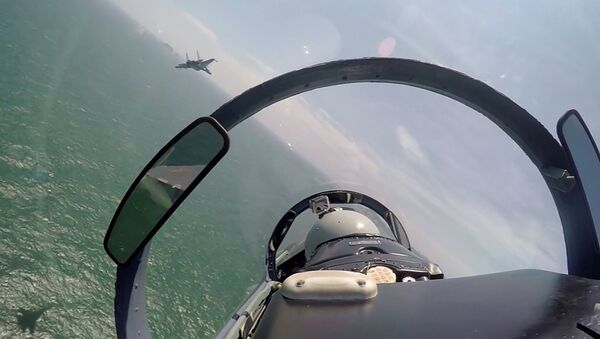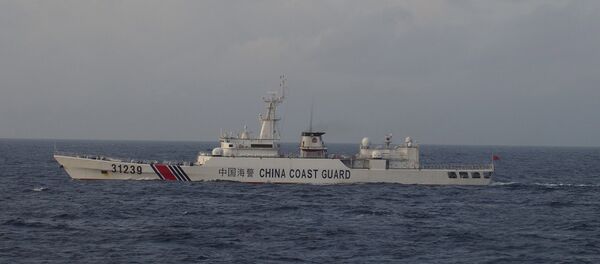The United States continues their efforts to contain China's activities in the East and South China Seas by weaponizing the ongoing maritime dispute between the Southeast Asian nations, Shen Shishun, director of the Center for South Pacific Studies of the Chinese Institute of International Studies, told Sputnik, suggesting that Washington's maneuvers will only bolster patriotic sentiment among the Chinese.
"The US is trying to curb China, relying on third countries," Shen told Sputnik China. "There is a conflict between China and Japan over islands in the East China Sea, but it is precisely because of the US that this problem emerged."
According to the Chinese academic, the Diaoyudao (Senkaku) Islands, which "historically belonged to Beijing," ended up in the hands of Japan due to Washington's post-WW2 foreign strategy.
"The United States deliberately misinterprets historical facts related to this matter, uses the situation around the islands to increase tension in Sino-Japanese relations and exploits the contradictions between China and its neighbors to curb [Beijing]," Shen said, adding that the US strategy is futile.
Dmitry Mosyakov, director of the Center for Southeast Asia, Australia and Oceania at the Institute of Oriental Studies, believes that the anti-China sentiment promoted by Washington and Tokyo could set relations between the US-Japanese alliance and China back decades.
According to Mosyakov, Washington and Tokyo are not seeking compromise on the Diaoyudao (Senkaku) territorial dispute, but, on the contrary, are fanning the flames over the archipelago.
ADMM-Plus is an annual meeting that brings together the defense ministers of 10 ASEAN countries and eight "dialogue partners," which include India, China, Japan, Australia, New Zealand, South Korea, Russia and the United States.
Mattis also held bilateral talks with Japanese Defense Minister Itsunori Onodera. The two "expressed serious concern about the situation in the South China Sea and reaffirmed their opposition to unilateral coercive actions by claimants, including the reclamation and militarization of disputed features, which alter the status quo and increase tensions," in a clear reference to China.

China's Charm Offensive: Beijing, Manila Manage to Reach Compromise
Speaking to Sputnik, Mosyakov highlighted that the Sino-Philippine relationship appears to be a viable alternative to the US-Japanese strategy: Beijing and Manila have managed to reach some compromises in the South China Sea. For instance, Philippine fishermen are allowed to fish in the area of Huangyan (Scarborough) shoal.
"China's relations with the Philippines show that… the discussion of existing problems between the two countries on a bilateral basis brings success," the Russian academic stressed.
At the same time Beijing opposes the involvement of external forces in its territorial disputes with neighboring states. This stance was voiced by Fu Ying, chairperson of the Foreign Affairs Committee of the National People's Congress of China, at the recent annual meeting of the International Valdai Discussion Club.
She confirmed China's readiness to continue negotiations on the islands, but spoke out against turning the disputes into an unnecessary geopolitical confrontation. She stressed that the interference of other countries, primarily the United States, in China's relations with neighbors may only escalate tensions in the region.
Meanwhile, the 19th National Congress of the Communist Party of China (CPC), which took place in Beijing on October 18-24, 2017, also addressed the issue of regional security. The congress's resolution envisages the modernization of the nation's defense as one of its top priorities. It also emphasizes the need to transform the People's Liberation Army (PLA) into a world-class armed force.
According to the South China Morning Post, the PLA Navy's South Sea Fleet has recently deployed a squadron of submarines to the disputed waters of the South China Sea to increase battle readiness.
Beijing's actions in the region prompt concerns among its ASEAN neighbors. Earlier, in March 2017, reports emerged claiming that China could have been involved in the militarization of its artificial islands in the South China Sea. In response, Chinese Defense Ministry spokesman Wu Qian admitted that Beijing had engaged in a large construction endeavor in the region, but said "most of the building is for civilian purposes."
Satellite imagery released in March 2017 depicted the buildup of a military installation on a northern island of the Paracels. According to Taiwanese media sources, the construction looked like "preparation for a harbor." They assumed that China may be seeking to bolster its naval presence in the maritime area. The Paracels are claimed by a number of countries, including China, Taiwan and Vietnam.








